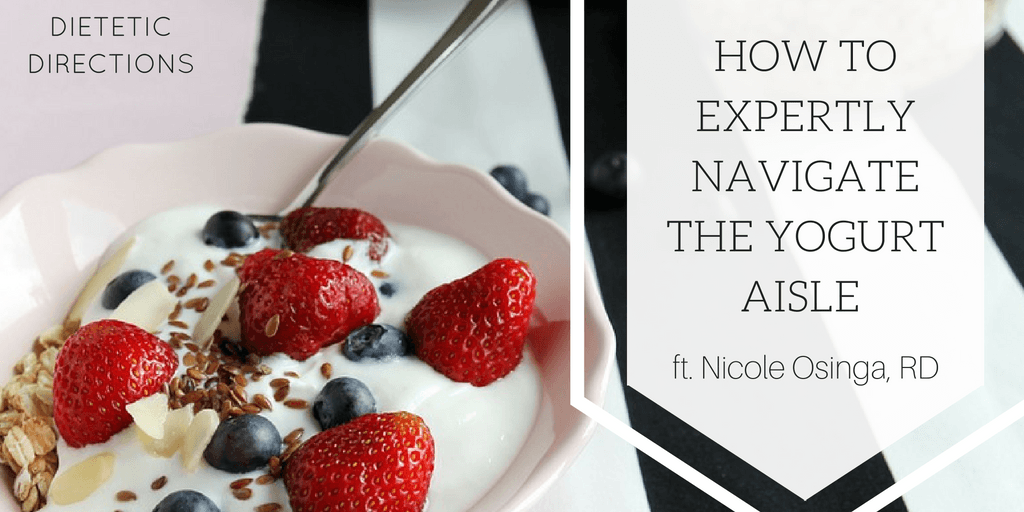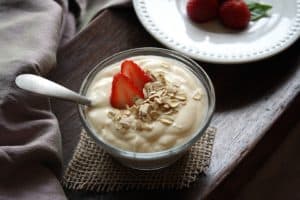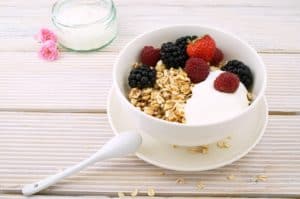
How to Expertly Navigate the Yogurt Aisle
To help us in navigating the mammoth yogurt aisle, it is my absolute pleasure to welcome Nicole Osinga as our dietitian guest blogger! Nicole and I connected over instagram where I began to learn more about her and her private practice in the Durum region. Nicole is also the contributor for the Toronto Star for column “Pump up my Snack”. Keep up the great work Nicole and thanks for helping us navigate the yogurt aisle!
In my opinion, the yogurt aisle is the most confusing and overwhelming aisle to navigate at the grocery store! It’s definitely the section I spend the longest time in. The yogurt aisle isn’t what it used to be – greek yogurt has recently taken over a sizeable chuck of the refrigerator case, leaving non-greeks to compete for the remaining real estate. Meanwhile, both greek and non-greek yogurts are branching out with new claims, nutrient content, flavours, ect.
I’ve compiled a couple of tips to help you navigate through the wild yogurt jungle.
Yogurt Basics
At least two strains of bacteria (lactobacillus bulgaricus and stretococcus thermophilus) are added to milk to make yogurt. You can tell if the bacteria are still alive if the words ‘probiotic’ or ‘live bacterial cultures’ appear on the label. These active bacterial cultures change lactose – milks naturally occurring sugar – to lactic acid. For this reason, people with lactose intolerance should have less symptoms with they eat yogurt.
What to Look for?
Overall, yogurt should be a good source of protein and calcium without providing excess added sugars or artificial sweeteners. One caution – Nutrition Facts Panels don’t list how much of the ‘sugars’ come from added sugar and how much comes from naturally occurring yogurt and the fruit.
Types of Yogurt
Greek Yogurt
- Traditionally, greek yogurt is made by straining ordinary yogurt, which removes some of the liquid whey and leaves more concentrated solid behind. This leaves traditional greek yogurts (Liberte and Danone Oikos) thick and rich, even if they’re fat free, and higher in protein (about 18 grams for 3/4 cup serving for 0% MF plain) than non-greeks (about 8 grams).
- However be aware of faux greek yogurts!! Yoplait (Source) does not create it’s greek yogurt the traditional way. They add milk protein concentrate and thickeners like corn starch or pectin.
- The only downside to traditional greek yogurts is that by straining out the calcium-rich whey, they end up with less calcium than non-greeks. Some greek yogurts separate their yogurts by ultrafiltration – passing the liquid through a semi-permeable membrane – to thicken their yogurts without separating the whey.These brands include Astro, IOGO and PC.
Probiotic Yogurt
- Probiotics are normally found in your digestive tract as part of the intestinal flora. Here, they help inhibit the growth of unfriendly, disease-causing bacteria and stimulate the body’s immune response
- In Canada, all yogurts are made with Lactobacillus bulgaricus and Streptococcus thermophilus and typically provide up to 300,000 live bacteria per serving, an amount most experts say is too low to provide health benefits. Experts say take 100 million cfu/day to benefit from probiotics. Some yogurt manufacturers have added other bacterial strains to increase the probiotic content of their products, ensuring these bacteria reach the intestinal tract where they exert their health benefits. For example, DanActive (Danone) and BioBest Maximmunité (Astro), provide 10 billion live bacteria per serving.
- The research still isn’t clear with the evidence regarding added probiotic bacteria contributing to gut health. Research to date has not shown significant health benefit from probiotic yogurt. Probiotics may however be beneficial in other situations. Check out this resource on how to choose a probiotic: Your Guide to Probiotics
Dairy-Free Yogurt
- Coconut yogurt: don’t expect much protein from these products (1-2 grams). It’s mostly just coconut milk, sugars, gums, starches with added calcium and magnesium. Brand includes “Yoso Coconut”.
- Almond yogurt: this product is also relatively low in protein (~ 3 grams) with added plain sugar (about 4 teaspoons per serving). Brand includes “Amande Creamy Cultured Almond.”
- Soy yogurt: Soy yogurt matched milk protein and has added calcium. This would be the best dairy-free yogurt alternative! Brand includes “Yoso Soygo”.
Higher Fat Yogurt
- Fat has found it’s way back into the yogurt aisle! Buzzwords indicating higher fat yogurts include “opulent” “authentic” “traditional” “indulge yourself” and “exceptionally rich”.
- We shouldn’t fear higher fat yogurts! Research is even showing that naturally occurring saturated fat in animal products such as meat and dairy isn’t harmful like once thought.
- One word of caution though – some higher yogurts have about half the protein of their lower-fat counterparts. This is because cream has less protein than milk and these yogurts aren’t strained to concentrate the protein. An example – Liberté Méditerranée has only 5 g protein for 3/4 cup.
Bottom Line:
Considering added sugars, calories, calcium and protein content, the following are my top picks from the yogurt aisle:
- PC 0% Plain Greek Yogurt
- Liberte 0% Plain Greek Yogurt
- Danone Oikos 0% Plain Greek Yogurt
All appear to be authentic greek yogurt, have 17-18 grams of protein per 3/4 cup serving and 1 gram of protein. A note that the PC Greek Yogurt does have a higher calcium (without added calcium) by using ultrafiltration (which as you may recall from above retains the whey part of the yogurt, which is where the calcium is found).



